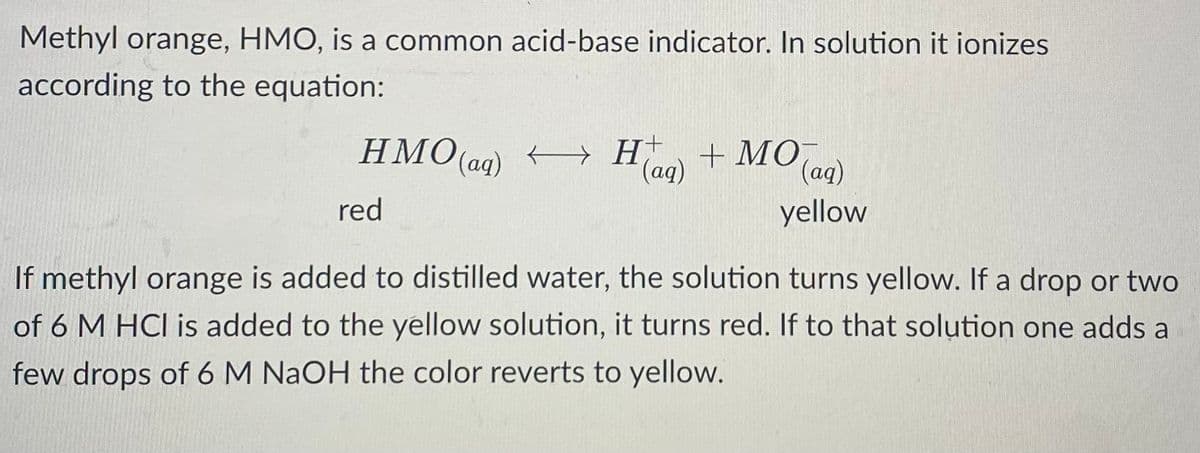Chemistry & Chemical Reactivity
10th Edition
ISBN:9781337399074
Author:John C. Kotz, Paul M. Treichel, John Townsend, David Treichel
Publisher:John C. Kotz, Paul M. Treichel, John Townsend, David Treichel
Chapter4: Stoichiometry: Quantitative Information About Chemical Reactions
Section4.5: Measuring Concentrations Of Compounds In Solution
Problem 4.6CYU: Sodium bicarbonate, NaHCO3, is used in baking powder formulations and in the manufacture of plastics...
Related questions
Question

Transcribed Image Text:Methyl orange, HMO, is a common acid-base indicator. In solution it ionizes
according to the equation:
HMO(aq) → H(aq) + MO (aq)
yellow
red
If methyl orange is added to distilled water, the solution turns yellow. If a drop or two
of 6 M HCI is added to the yellow solution, it turns red. If to that solution one adds a
few drops of 6 M NaOH the color reverts to yellow.
![Why does adding 6 M HCI to the yellow solution of methyl orange tend to cause the color to
change to red?
OHCI dissociates into H* and Cl ions. This leads to an increase in [H*], resulting in a shift to the left to form
HMO.
OHCI dissociates into H* and Cl ions. This leads to an increase in [CI], resulting in separate reaction that can
form HMO.
OHCI reacts with water in the aqueous solution to form HMO.
O None of these.](/v2/_next/image?url=https%3A%2F%2Fcontent.bartleby.com%2Fqna-images%2Fquestion%2F70e5c0de-fdc0-430a-a1f8-b8d8bd343e8f%2F34e0e24e-59e4-4152-8759-bf5b579dd4ab%2Fw21qcyk_processed.jpeg&w=3840&q=75)
Transcribed Image Text:Why does adding 6 M HCI to the yellow solution of methyl orange tend to cause the color to
change to red?
OHCI dissociates into H* and Cl ions. This leads to an increase in [H*], resulting in a shift to the left to form
HMO.
OHCI dissociates into H* and Cl ions. This leads to an increase in [CI], resulting in separate reaction that can
form HMO.
OHCI reacts with water in the aqueous solution to form HMO.
O None of these.
Expert Solution
This question has been solved!
Explore an expertly crafted, step-by-step solution for a thorough understanding of key concepts.
Step by step
Solved in 2 steps

Knowledge Booster
Learn more about
Need a deep-dive on the concept behind this application? Look no further. Learn more about this topic, chemistry and related others by exploring similar questions and additional content below.Recommended textbooks for you

Chemistry & Chemical Reactivity
Chemistry
ISBN:
9781337399074
Author:
John C. Kotz, Paul M. Treichel, John Townsend, David Treichel
Publisher:
Cengage Learning

Chemistry & Chemical Reactivity
Chemistry
ISBN:
9781133949640
Author:
John C. Kotz, Paul M. Treichel, John Townsend, David Treichel
Publisher:
Cengage Learning

Chemistry: Principles and Practice
Chemistry
ISBN:
9780534420123
Author:
Daniel L. Reger, Scott R. Goode, David W. Ball, Edward Mercer
Publisher:
Cengage Learning

Chemistry & Chemical Reactivity
Chemistry
ISBN:
9781337399074
Author:
John C. Kotz, Paul M. Treichel, John Townsend, David Treichel
Publisher:
Cengage Learning

Chemistry & Chemical Reactivity
Chemistry
ISBN:
9781133949640
Author:
John C. Kotz, Paul M. Treichel, John Townsend, David Treichel
Publisher:
Cengage Learning

Chemistry: Principles and Practice
Chemistry
ISBN:
9780534420123
Author:
Daniel L. Reger, Scott R. Goode, David W. Ball, Edward Mercer
Publisher:
Cengage Learning


Chemistry: An Atoms First Approach
Chemistry
ISBN:
9781305079243
Author:
Steven S. Zumdahl, Susan A. Zumdahl
Publisher:
Cengage Learning

Chemistry
Chemistry
ISBN:
9781305957404
Author:
Steven S. Zumdahl, Susan A. Zumdahl, Donald J. DeCoste
Publisher:
Cengage Learning